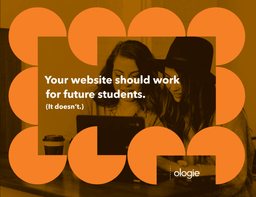Your website should work for future students. (It doesn’t.)
Consider the higher ed website. When it’s done well, it creates clarity, answers questions, and inspires action. When it’s not? It’s a frustrating experience that could make future students drop you from their search before they give you a chance.
We recently fielded an online survey that tested some tried-and-true higher ed terminology, UX designs, and preferences with high school students.
What we found might just make you rethink your web experience entirely.
ABOUT THE STUDY
A total of 890 students completed the survey. The sample consisted of current high school students with self-reported intent to apply to a four-year college or university. The population was evenly distributed among the four major regions of the U.S., with race represented at 50% historically marginalized groups and 50% white. This distribution was true for each of the two websites. The online survey was in the field from November 7 to 14, 2022.

Know where they’re coming from.
How do future students get to higher ed websites?
Are they going directly to your site as a first step, or coming from a search engine? Are you overemphasizing your home page if high schoolers are searching specifically for programs and majors?
These questions are important, because this context can help you make decisions about structure and content, whether that's from the outside in or the inside out.

Focus on what matters most to them.
What information should you elevate? What can you downplay?
Every faculty and staff member, every club and committee — every campus stakeholder is going to tell you that their content is the most important. These of course are opinions. But the facts can help you outline and design an experience that prioritizes exactly what future students are looking for.

Rethink your terminology.
Do future students actually understand you?
Like every industry, higher ed has its own jargon. And when you have to boil things down to a single word for navigation, it can get tricky for your users. Can you realistically expect a high schoolers to know what you're saying?
The content behind these terms and labels is so critical. But if you want students to get the intended information, you need to guide them in a more accessible way.

Tell it like it is.
Do future students trust higher ed websites?
How can your audience get a real, unfiltered sense for campus culture, when you spend so much time selling a curated experience? Where do you draw the line between information and inspiration for your website content?

Keep it simple, not sparse.
What about layout?
We know that all college websites aren’t created equal. But which aspects of a site’s design make it a more appealing experience? How do things like layout, tone, and other creative choices change the experience for your students?
So we sought to get feedback and understand the implications for a site beyond just content and information priorities, diving into the good, the bad—and the ugly of site design.
